1006-23-1
| Name | 5-Nitroso-2,4,6-triaminopyrimidine |
|---|---|
| Synonyms |
2,4,6-Triamino-5-nitrosopyrimidine
EINECS 213-742-7 2,4,6-Pyrimidinetriamine, 5-nitroso- 5-Nitrosopyrimidin-2,4,6-triamin 5-nitrosopyrimidine-2,4,6-triamine 5-Nitroso-2,4,6-tria 5-Nitroso-pyrimidin-2,4,6-triyltriamin 5-Nitroso-pyriMidine-2 5-nitroso-pyrimidine-2,4,6-triyltriamine MFCD00006096 5-Nitroso-2,4,6-pyrimidinetriamine 2,4,6-triamino-5-nitroso-pyrimidine IFLAB-BB F1918-0051 5-Nitroso-2 6-pyrimidinetriamine,5-nitroso-4 6-triaMine TRIAMINO-5-NITROSOPYRIMIDINE 5-nitroso-pyrimidine-2,4,6-triamine |
| Density | 2.2±0.1 g/cm3 |
|---|---|
| Boiling Point | 602.9±65.0 °C at 760 mmHg |
| Melting Point | 300 °C |
| Molecular Formula | C4H6N6O |
| Molecular Weight | 154.130 |
| Flash Point | 318.4±34.3 °C |
| Exact Mass | 154.060303 |
| PSA | 133.27000 |
| LogP | -0.98 |
| Vapour Pressure | 0.0±1.7 mmHg at 25°C |
| Index of Refraction | 1.964 |
| Stability | Stable. Incompatible with strong oxidizing agents. |
Synonym: Section 2 - COMPOSITION, INFORMATION ON INGREDIENTS
Risk Phrases: None Listed. Section 3 - HAZARDS IDENTIFICATION EMERGENCY OVERVIEW
The toxicological properties of this material have not been fully investigated. Potential Health Effects Eye: Dust may cause mechanical irritation. The toxicological properties of this material have not been fully investigated. Skin: May cause skin irritation. The toxicological properties of this material have not been fully investigated. Ingestion: May cause digestive tract disturbances. The toxicological properties of this substance have not been fully investigated. Inhalation: May cause respiratory tract irritation. The toxicological properties of this substance have not been fully investigated. Chronic: No information found. Section 4 - FIRST AID MEASURES Eyes: Flush eyes with plenty of water for at least 15 minutes, occasionally lifting the upper and lower eyelids. Get medical aid immediately. Skin: Get medical aid. Flush skin with plenty of water for at least 15 minutes while removing contaminated clothing and shoes. Wash clothing before reuse. Ingestion: If victim is conscious and alert, give 2-4 cupfuls of milk or water. Never give anything by mouth to an unconscious person. Get medical aid immediately. Inhalation: Remove from exposure and move to fresh air immediately. If not breathing, give artificial respiration. If breathing is difficult, give oxygen. Get medical aid. Notes to Physician: Section 5 - FIRE FIGHTING MEASURES General Information: As in any fire, wear a self-contained breathing apparatus in pressure-demand, MSHA/NIOSH (approved or equivalent), and full protective gear. During a fire, irritating and highly toxic gases may be generated by thermal decomposition or combustion. Extinguishing Media: Use water spray, dry chemical, carbon dioxide, or appropriate foam. Section 6 - ACCIDENTAL RELEASE MEASURES General Information: Use proper personal protective equipment as indicated in Section 8. Spills/Leaks: Clean up spills immediately, observing precautions in the Protective Equipment section. Sweep up or absorb material, then place into a suitable clean, dry, closed container for disposal. Avoid generating dusty conditions. Provide ventilation. Section 7 - HANDLING and STORAGE Handling: Wash thoroughly after handling. Remove contaminated clothing and wash before reuse. Use with adequate ventilation. Minimize dust generation and accumulation. Avoid contact with eyes, skin, and clothing. Keep container tightly closed. Avoid ingestion and inhalation. Storage: Keep container closed when not in use. Store in a tightly closed container. Store in a cool, dry, well-ventilated area away from incompatible substances. Section 8 - EXPOSURE CONTROLS, PERSONAL PROTECTION Engineering Controls: Use adequate ventilation to keep airborne concentrations low. Exposure Limits CAS# 1006-23-1: Personal Protective Equipment Eyes: Wear appropriate protective eyeglasses or chemical safety goggles as described by OSHA's eye and face protection regulations in 29 CFR 1910.133 or European Standard EN166. Skin: Wear appropriate protective gloves to prevent skin exposure. Clothing: Wear appropriate protective clothing to prevent skin exposure. Respirators: Follow the OSHA respirator regulations found in 29 CFR 1910.134 or European Standard EN 149. Use a NIOSH/MSHA or European Standard EN 149 approved respirator if exposure limits are exceeded or if irritation or other symptoms are experienced. Section 9 - PHYSICAL AND CHEMICAL PROPERTIES Physical State: Powder Color: pink Odor: Not available. pH: Not available. Vapor Pressure: Not available. Viscosity: Not available. Boiling Point: Not available. Freezing/Melting Point: > 300 deg C Autoignition Temperature: Not available. Flash Point: Not available. Explosion Limits, lower: Not available. Explosion Limits, upper: Not available. Decomposition Temperature: Solubility in water: Specific Gravity/Density: Molecular Formula: C4H6N6O Molecular Weight: 154.13 Section 10 - STABILITY AND REACTIVITY Chemical Stability: Stable under normal temperatures and pressures. Conditions to Avoid: Incompatible materials, dust generation, strong oxidants. Incompatibilities with Other Materials: Strong oxidizing agents. Hazardous Decomposition Products: Nitrogen oxides, carbon monoxide, carbon dioxide. Hazardous Polymerization: Has not been reported Section 11 - TOXICOLOGICAL INFORMATION RTECS#: CAS# 1006-23-1 unlisted. LD50/LC50: Not available. Carcinogenicity: 5-Nitroso-2,4,6-pyrimidinetriamine - Not listed by ACGIH, IARC, or NTP. Section 12 - ECOLOGICAL INFORMATION Section 13 - DISPOSAL CONSIDERATIONS Dispose of in a manner consistent with federal, state, and local regulations. Section 14 - TRANSPORT INFORMATION IATA Not regulated as a hazardous material. IMO Not regulated as a hazardous material. RID/ADR Not regulated as a hazardous material. Section 15 - REGULATORY INFORMATION European/International Regulations European Labeling in Accordance with EC Directives Hazard Symbols: Not available. Risk Phrases: Safety Phrases: S 24/25 Avoid contact with skin and eyes. S 28A After contact with skin, wash immediately with plenty of water. S 37 Wear suitable gloves. S 45 In case of accident or if you feel unwell, seek medical advice immediately (show the label where possible). WGK (Water Danger/Protection) CAS# 1006-23-1: No information available. Canada CAS# 1006-23-1 is listed on Canada's DSL List. CAS# 1006-23-1 is not listed on Canada's Ingredient Disclosure List. US FEDERAL TSCA CAS# 1006-23-1 is listed on the TSCA inventory. SECTION 16 - ADDITIONAL INFORMATION N/A |
| Symbol |

GHS07 |
|---|---|
| Signal Word | Warning |
| Hazard Statements | H315-H319-H335 |
| Precautionary Statements | P305 + P351 + P338 |
| Hazard Codes | Xn |
| Risk Phrases | R36/37/38 |
| Safety Phrases | S24/25 |
| RIDADR | NONH for all modes of transport |
|
~71% 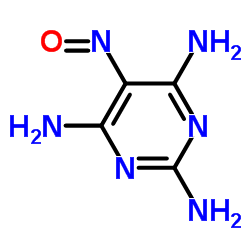
1006-23-1 |
| Literature: Journal of Heterocyclic Chemistry, , vol. 22, # 5 p. 1369 - 1372 |
|
~% 
1006-23-1 |
| Literature: Journal of the American Chemical Society, , vol. 81, p. 2448,2451 |
|
~% 
1006-23-1 |
| Literature: Nippon Kagaku Zasshi, , vol. 72, p. 866 Chem.Abstr., , p. 5946 Helvetica Chimica Acta, , vol. 42, p. 1604,1608 |
| Precursor 3 | |
|---|---|
| DownStream 10 | |
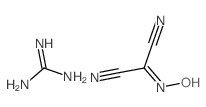
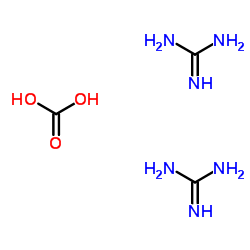
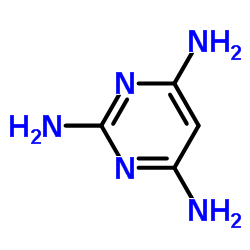

![N-[4-(2,4,7-triaminopteridin-6-yl)phenyl]methanesulfonamide structure](https://image.chemsrc.com/caspic/433/142731-14-4.png)
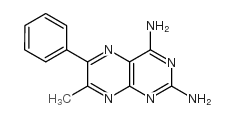

![[1,2,5]oxadiazolo[3,4-d]pyrimidine-5,7-diamine structure](https://image.chemsrc.com/caspic/320/30745-07-4.png)
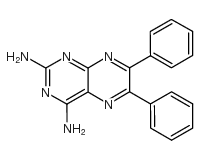
![6,8-diamino-1H-pyrimido[5,4-g]pteridine-2,4-dione structure](https://image.chemsrc.com/caspic/390/7147-37-7.png)
![8-thia-2,4,7,9-tetrazabicyclo[4.3.0]nona-2,4,6,9-tetraene-3,5-diamine structure](https://image.chemsrc.com/caspic/460/7598-40-5.png)
![naphtho[1,2-g]pteridine-9,11-diamine structure](https://image.chemsrc.com/caspic/207/63110-97-4.png)
